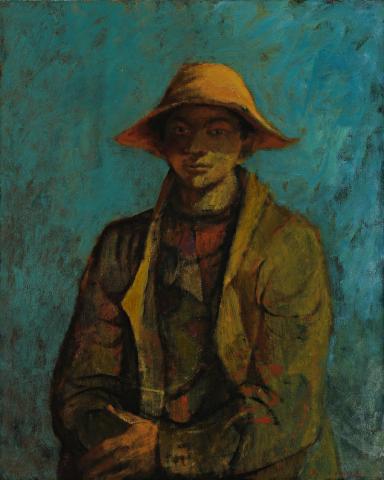MALAY BOY, BROOME, 1959
RUSSELL DRYSDALE
oil on canvas
75.5 x 60.0 cm
signed lower right: Russell Drysdale
Macquarie Galleries, Sydney
Private collection
Thence by descent
Private collection
Christies, Melbourne, 24 November 1999,lot 100 (illus. front cover of catalogue)
Private collection, Melbourne
Christmas Exhibition, Macquarie Galleries, Sydney, 9–23 December 1959, cat. 5
Russell Drysdale: Retrospective 1937–1960, Art Gallery of New South Wales, Sydney,5 October – 6 November 1960, cat. 107 (illus.)
Russell Drysdale, John Martin's Auditorium, Adelaide, 4–21 March 1964, cat. 55
Russell Drysdale Paintings 1940–72, S.H. Ervin Gallery, Sydney, 14 June – 21 July 1985, cat. 43
Russell Drysdale 1912–1981, National Gallery of Victoria, Melbourne, 19 December 1997 – 9 March 1998; Art Gallery of New South Wales, Sydney, 27 March – 10 May 1998; Queensland Art Gallery, Brisbane, 18 May – 28 June 1998; Museum and Art Gallery of the Northern Territory, Darwin,20 July – 30 August 1998; Tasmanian Museum and Art Gallery, Hobart, 23 September – 15 November 1998, cat. 62
Haefliger, P., 'Christmas Exhibition at Macquarie Galleries', Sydney Morning Herald, 9 December 1959, p. 2 Dutton, G., Russell Drysdale, Thames and Hudson, London, 1964, pp. 69, 190, cat. 103, pl. 103 (illus.)
Klepac, L., The Life and Work of Russell Drysdale, Bay Books, Sydney, 1983, pl. 144 (illus.)
Smith, G., Russell Drysdale, National Gallery of Victoria, Melbourne, 1997, pp. 156–157 (illus.)
Malay Boys, Broome, c.1957, pen and red ink, grey wash on grey paper, 24.2 x 19.8 cm, collection of the Art Gallery of New South Wales, Sydney
When Russell Drysdale's Malay Boy, Broome, 1959 was exhibited in the Macquarie Galleries Christmas group show of December 1959, it was singled out for special comment by Paul Haefliger, art critic for The Sydney Morning Herald. 'Drysdale [he said] with considerable power realises once again his familiar rich romanticism in 'Malay Boy, Broome.' Although the young subject looks, in his heavily weighted attire, more like a peasant from Provence, the painting has a sonorous harmony of glowing deep reds and earth greens, which in turn are coupled with a fine simplicity of forms to create a mellow resonance of mood.'1 The opulent colour and triangular structure are striking, demonstrating Drysdale's remarkable palette touched by the splendour of the Venetian masters, and his classic sense of composition. The very considerable appeal of the painting's formal excellence, however, should not diver the viewer from its other qualities, especially the artist's deeply felt humanism.
Drysdale visited Broome, the pearling town in the Kimberley region of Western Australia, during his 1956 trip to the Northern Territory. It fascinated him as seen in paintings it inspired, Youth at Broome, 1958, in the Wesfarmers Collection, Perth, and Basketball at Broome, 1958, Sussan Corporation Collection. Writing in the catalogue to his London exhibition at the Leicester Galleries in April 1958, where many of these and other such masterpieces as The Red Shirt, 1958 and Landscape in the Kimberleys were shown, Drysdale reflected on this land of 'ancient grandeur indifferent to the challenge of man'. Full of wry contrast and camaraderie, it embraced 'the great red deserts of the centre' to 'The white, tin town of Broome whose pearls find their market in Paris.'2 Malay Boy, Broome, 1959 was painted on his return to Australia after a year in London. Characteristically up close in presentation, the static pose of the figure fills half the picture, the rest by the setting of colours of mixed turquoise. In the related painting, Diver at Broome, 1959,(once in the collection of Dr Joseph Brown), the substance of the figure blends into its surrounds, forming part of the landscape. This is a favoured approach seen elsewhere in such moving paintings of Aborigines as The Rainmaker, 1958 and Snake Bay at Night, 1959, in the collection of the Tasmanian Museum and Art Gallery, Hobart. The Malay boy is likewise at ease in his environment as Drysdale put aside the hot red landscape of the outback for the cool aquamarine waters surrounding Broome - where pearls are found. Here, the blue-greens of the sea and the interplay of lights and darks create a subaqueous effect. Painterly and tactile, they envelope the figure in watery isolation. Though his face be masked by shadow, his pose expresses inner strength, as the colours in his garments touch upon the exotic.
1. Haefliger, P., 'Christmas Exhibition at Macquarie Galleries', Sydney Morning Herald, 9 December 1959, p. 2
2. Drysdale, R., March 1958, in 'Capricornia' Russell Drysdale [catalogue], The Leicester Galleries, London, April 1958, pp. 3, 4
DAVID THOMAS
